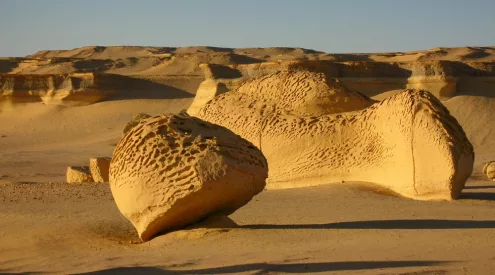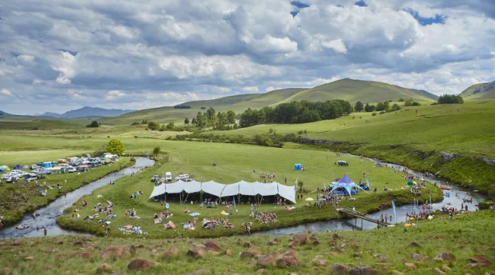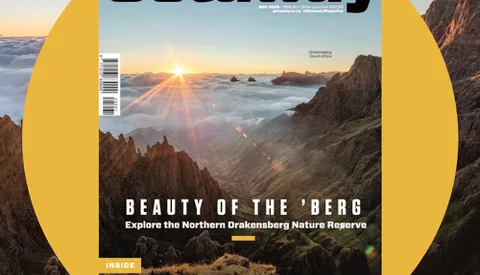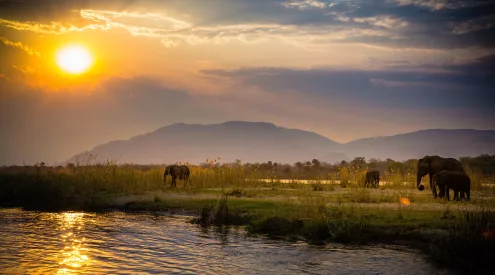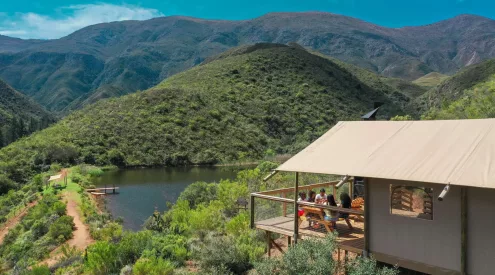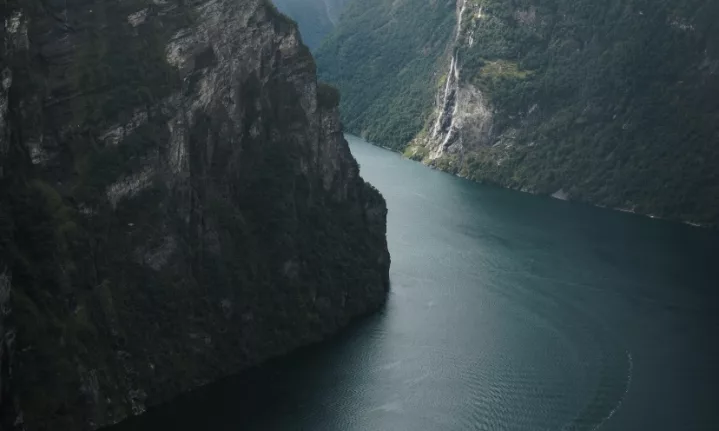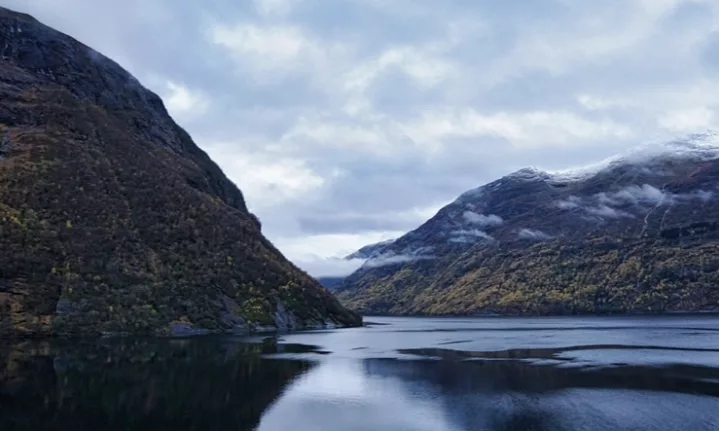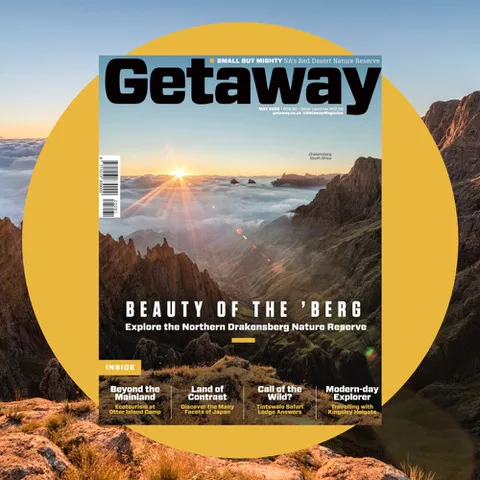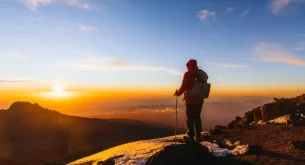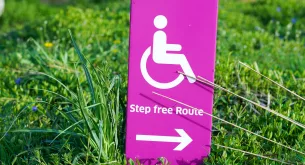Standing alone on the top deck of the Bolsøy for the ferry ride from Hellesylt to Geiranger, there was a crisp chill in the air.
Although it was springtime, the crystal-clear Geirangerfjord was enveloped in mist. The last whispers of winter were fading, the summer visitors had yet to arrive, and the fjord, minus the high-season crowds and cruise ships, was silent and tranquil.

The boat cut through the glassy water. Sheer rock walls stretched spectacularly upwards. Long abandoned farmhouses, where people had once eked out a living, clung precariously to tiny grassy ledges. Slender waterfalls streamed down the cliffs to meet the surface of the fjord – the De syv søstre (The Seven Sisters), Friaren (The Suitor) and Brudesløret (The Bridal Veil).
In a region with no shortage of them, the 15 km-long UNESCO World Heritage Geirangerfjord is a place of outstanding natural beauty. The deep, blue, serpentine fjord is one of the crown jewels of Norway’s western fjords, and as the hour-long journey ended and we approached the town of Geiranger, the fjord opened around us like a vast, ancient theatre.
The Scandinavian word hygge, the concept of cosying up and getting comfortable at home, has become well-known globally over the last few years. The Norwegians have the word friluftsliv, which is the philosophy of embracing outdoor activities and immersing yourself in nature. Where better to do this than in the fjords?
A RIB-boat tour on the Geirangerfjord certainly had me friluftsliv. I don’t think I could have embraced an outdoor activity, or my seat, any tighter! A RIB (rigid inflatable boat) is undoubtedly the fastest way to see the fjord. Assembling at an old boathouse down by the fjord, we were handed insulated drysuits before clambering aboard the boat.
As we headed out on the water, it felt like we were in a scene from a nature documentary, except this time, we were not watching it on the Discovery Channel but were right in the heart of the action. The air was crisp and fresh. We zipped, zoomed and zigzagged across the water. The wind whipped loose strands of hair into my face, and the salty spray misted my sunglasses. The rugged cliffs towered above us as the boat navigated high-speed twists and turns.
We cruised deep into the heart of the fjord, and the captain cut the engine. Sudden silence, interrupted only by the eerie cry of an eagle and the distant rumble of a waterfall cascading down the mountainside. We looked for the seals and porpoises that often call these waters home and wondered again about the harsh lives of the people who’d once eked out a living at the abandoned farmhouses above us.
Two hours from the tiny town of Geiranger, Ålesund could have been taken right out of the pages of a fairy tale. Built on a row of islands extending into the Atlantic Ocean on the north-west coast of Norway, this cobblestone area is widely regarded as Norway’s most beautiful town. A devastating fire in 1904 left much of Ålesund in ashes. During the 16-hour-long disaster, over 850 houses burned to the ground, leaving 10 000 people homeless.
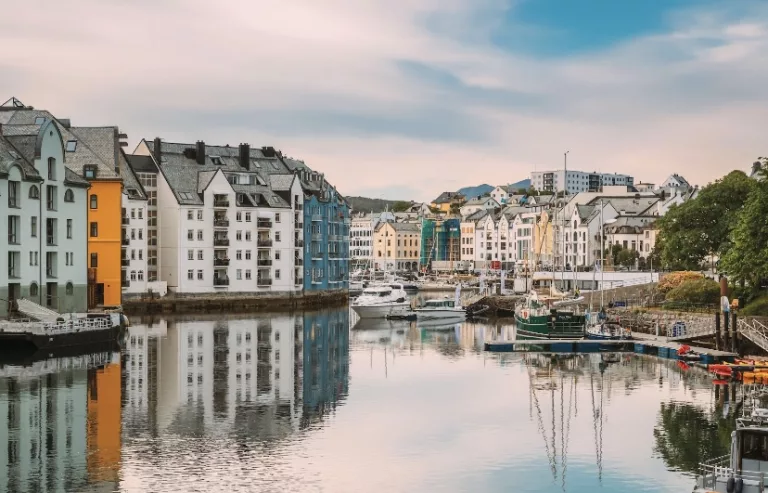
Rebuilt after the fire, Ålesund now has the world’s finest concentration of Art Nouveau buildings and is in the middle of the ocean, islands and Norway’s best fjords, making it the perfect base for exploring this awe-inspiring part of the world.
One of the first things to do in Ålesund is lace up your walking shoes and hit the cobblestone streets. To learn more about the town and its history and architecture, visit the Art Nouveau Centre & Art Museum KUBE. For a panoramic view of the city, climb the 418 steps from the town park to the Mount Aksla viewpoint – there’s a restaurant at the top if you need something to eat or drink while you catch your breath. Get up close to some of the marine life by visiting Atlanterhavsparken, Northern Europe’s largest saltwater aquarium and marine science centre. Prepare to be charmed by otters, seals, and Humboldt penguins. Try to time your visit for seal feeding time, which is very entertaining – who knew seals had such amusing personalities?
Ålesund is sometimes known as ‘the Venice of Norway’, thanks to its canals and narrow streets. We spent a morning kayaking along the beautiful Brosundet canal, which snakes through the town centre. The water’s surface mirrored the colours and shapes of buildings lining the canal. We paddled past the small cafes and shops hugging the waterfront, their outdoor terraces buzzing with activity. The smell of coffee drifted over the water. Seagulls cried to one another in the sky overhead, and we could hear the distant hum of fishing boats and ferries.
Passing under the low bridges that spanned the canal, we overheard the chatter of people crossing above us. Reaching one end, we passed under a bridge and popped out near the Stornespiren/Prestebrygga cruise boat terminal. Bobbing there, we could see the cruise ships and passenger ferries moored at the docks. At the other end, we passed the rusty red Molja Lighthouse. The lighthouse, which has stood at the end of the jetty, guiding ships into the harbour for over a century and a half, is now a tiny hotel room measuring only three metres across. Turning the kayaks around, we left the lighthouse and returned to the dock.
Ålesund is home to Norway’s most important fishing harbour, so fresh seafood is on the menu – it is so fresh you can buy it straight from the fishermen in their bright yellow waterproof overalls, who sell it directly from their boats in the canals. Many of the town’s restaurants serve delicious local food, with seasonal ingredients dictating the menu.
Cod and salmon are some of the local delicacies, as is klippfisk or klipfish, which is dried, salted cod – the fish is boned, preserved in salt for a month, washed and very slowly dried. The tradition has been around since the 1700s, and you must try it, but maybe only once, because it’s an ‘acquired taste’!
Leaving Ålesund, we headed out of town. As we travelled the winding roads that led out of the tiny coastal fishing town and headed into the Norwegian backcountry, we passed some of the most dramatic landscapes imaginable.
ALSO READ: Why Ibiza should be on your bucket list
Nordfjord was our next destination, between Norway’s wild coast and the largest glacier in Europe, the 487 km² Jostedalsbreen. At Loen, Nordfjord’s most inland village, the Skylift whisked us from the fjord’s edge to the top of Mount Hoven, 1 011 m above sea level, in mere minutes. Once at the top, I tried my hand at snowshoeing and sledging. My snow skills were somewhat lacking, but the panoramic views over the fjord more than made up for it. As did lunch in the restaurant perched on the edge of the snow-covered cliff. It was like a scene from a James Bond movie. And if you feel like channelling 007, a hair-raising ski descent down the 1 000 m from the restaurant is an option in winter!
If you are into skiing, the fjords are the place to be in winter and spring. Norway may not yet be on your radar for ski resorts, but it has plenty of them, and skiing there is more affordable than in the Swiss or French Alps – insiders consider the Norwegian Alps one of the best places in the world to ski. Where else on Earth can you ski with views of the wild fjord landscapes and an almost seven-month ski season? Ski season starts in November and often goes on as late as the middle of May. If you go early in the season, you can experience snow to sea level or avoid the crowds by visiting towards the end of the season. With hundreds of alpine peaks over 1 000 metres, you can make fresh tracks every day of your trip.
The following day, I felt it was time to hit the ski slopes – seriously, this time – at the nearby Strandafjellet Ski Resort in the gorgeous Sunnmøre Alps, which has seven ski lifts, 18 downhills and could be Scandinavia’s best free-skiing area. Waiting for the gondola, skiers of various ages but undeniably skilled zoomed down the slopes. Toddlers, teens and tenacious old-timers gracefully gliding, carving through the snow with ease, their skis cutting fresh tracks into the snow, their bright jackets a vivid contrast to the mountain’s brilliant white.
I was intimidated. I was relieved to see my guide carrying snowshoes and not skis for me when I disembarked from the gondola. He told me it had rained the night before, and the slopes were too icy for someone like me, who hadn’t skied in years. Better safe than sorry. Leaving the downhill slopes to the skilful, stylish skiers, I waddled off in what felt like oversized flip-flops with all the finesse of a determined penguin.
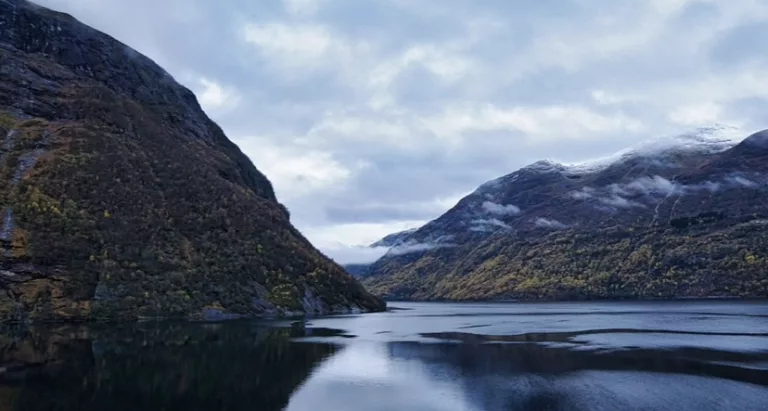
After an hour or so of trudging about, we reached a singularly surreal sight: a line of bright red deck chairs in the snow, the perfect spot to sit and look out over the bright blue fjord a long way down. With a warm solbærtoddy (blackcurrant tea) in my hand, I decided I’d have to give skiing there another go sometime. The area is popular with hiking enthusiasts, so maybe I’ll return in the summer and visit some of the trails.
Norway’s western fjords are the perfect blend of natural beauty and exciting outdoor adventures. From the serene, misty waters of the Geirangerfjord to the ski slopes of the Sunnmøre Alps or the canals of the charming Art Nouveau town of Ålesund, this part of the world is about embracing outdoor life.
This article was written by Sarah Kingdom for Getaway’s August 2024 print edition. Find us on shelves for more!
Pictures: Sourced/Courtesy Images
Follow us on social media for more travel news, inspiration, and guides. You can also tag us to be featured.
TikTok | Instagram | Facebook | Twitter
ALSO READ: Switzerland’s new passport is Ana innovative blend of art and tech



